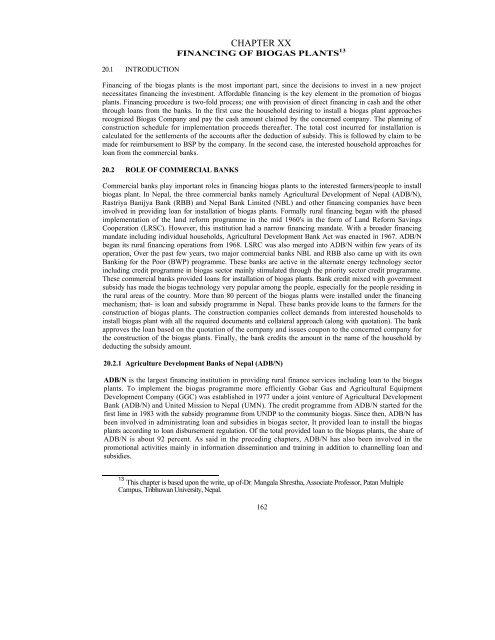download (pdf, 6MB) - SNV
download (pdf, 6MB) - SNV
download (pdf, 6MB) - SNV
You also want an ePaper? Increase the reach of your titles
YUMPU automatically turns print PDFs into web optimized ePapers that Google loves.
20.1 INTRODUCTION<br />
CHAPTER XX<br />
FINANCING OF BIOGAS PLANTS 13<br />
Financing of the biogas plants is the most important part, since the decisions to invest in a new project<br />
necessitates financing the investment. Affordable financing is the key element in the promotion of biogas<br />
plants. Financing procedure is two-fold process; one with provision of direct financing in cash and the other<br />
through loans from the banks. In the first case the household desiring to install a biogas plant approaches<br />
recognized Biogas Company and pay the cash amount claimed by the concerned company. The planning of<br />
construction schedule for implementation proceeds thereafter. The total cost incurred for installation is<br />
calculated for the settlements of the accounts after the deduction of subsidy. This is followed by claim to be<br />
made for reimbursement to BSP by the company. In the second case, the interested household approaches for<br />
loan from the commercial banks.<br />
20.2 ROLE OF COMMERCIAL BANKS<br />
Commercial banks play important roles in financing biogas plants to the interested farmers/people to install<br />
biogas plant. In Nepal, the three commercial banks namely Agricultural Development of Nepal (ADB/N),<br />
Rastriya Banijya Bank (RBB) and Nepal Bank Limited (NBL) and other financing companies have been<br />
involved in providing loan for installation of biogas plants. Formally rural financing began with the phased<br />
implementation of the land reform programme in the mid 1960's in the form of Land Reform Savings<br />
Cooperation (LRSC). However, this institution had a narrow financing mandate. With a broader financing<br />
mandate including individual households, Agricultural Development Bank Act was enacted in 1967. ADB/N<br />
began its rural financing operations from 1968. LSRC was also merged into ADB/N within few years of its<br />
operation, Over the past few years, two major commercial banks NBL and RBB also came up with its own<br />
Banking for the Poor (BWP) programme. These banks are active in the alternate energy technology sector<br />
including credit programme in biogas sector mainly stimulated through the priority sector credit programme.<br />
These commercial banks provided loans for installation of biogas plants. Bank credit mixed with government<br />
subsidy has made the biogas technology very popular among the people, especially for the people residing in<br />
the rural areas of the country. More than 80 percent of the biogas plants were installed under the financing<br />
mechanism; that- is loan and subsidy programme in Nepal. These banks provide loans to the farmers for the<br />
construction of biogas plants. The construction companies collect demands from interested households to<br />
install biogas plant with all the required documents and collateral approach (along with quotation). The bank<br />
approves the loan based on the quotation of the company and issues coupon to the concerned company for<br />
the construction of the biogas plants. Finally, the bank credits the amount in the name of the household by<br />
deducting the subsidy amount.<br />
20.2.1 Agriculture Development Banks of Nepal (ADB/N)<br />
ADB/N is the largest financing institution in providing rural finance services including loan to the biogas<br />
plants. To implement the biogas programme more efficiently Gobar Gas and Agricultural Equipment<br />
Development Company (GGC) was established in 1977 under a joint venture of Agricultural Development<br />
Bank (ADB/N) and United Mission to Nepal (UMN). The credit programme from ADB/N started for the<br />
first lime in 1983 with the subsidy programme from UNDP to the community biogas. Since then, ADB/N has<br />
been involved in administrating loan and subsidies in biogas sector, It provided loan to install the biogas<br />
plants according to loan disbursement regulation. Of the total provided loan to the biogas plants, the share of<br />
ADB/N is about 92 percent. As said in the preceding chapters, ADB/N has also been involved in the<br />
promotional activities mainly in information dissemination and training in addition to channelling loan and<br />
subsidies.<br />
13 This chapter is based upon the write, up of-Dr: Mangala Shrestha, Associate Professor, Patan Multiple<br />
Campus, Tribhuwan University, Nepal.<br />
162
















